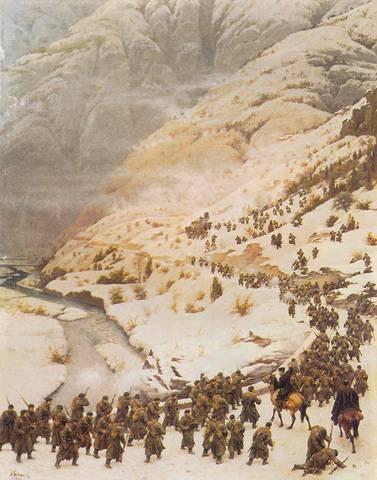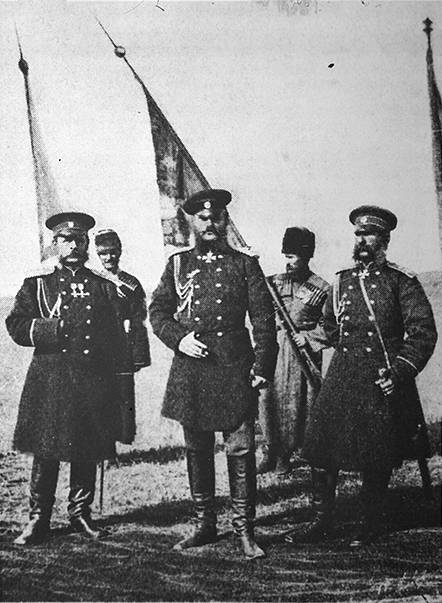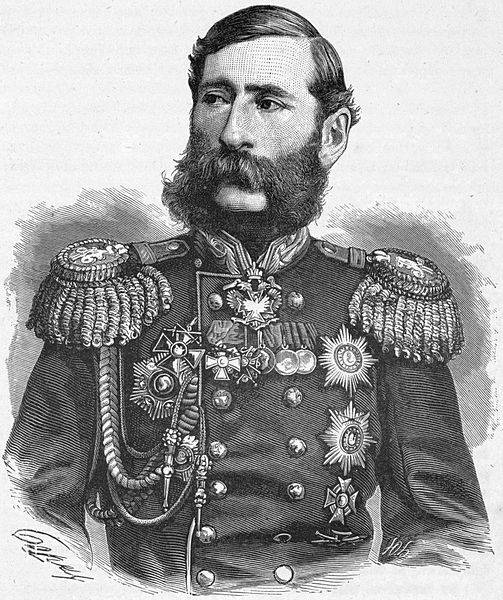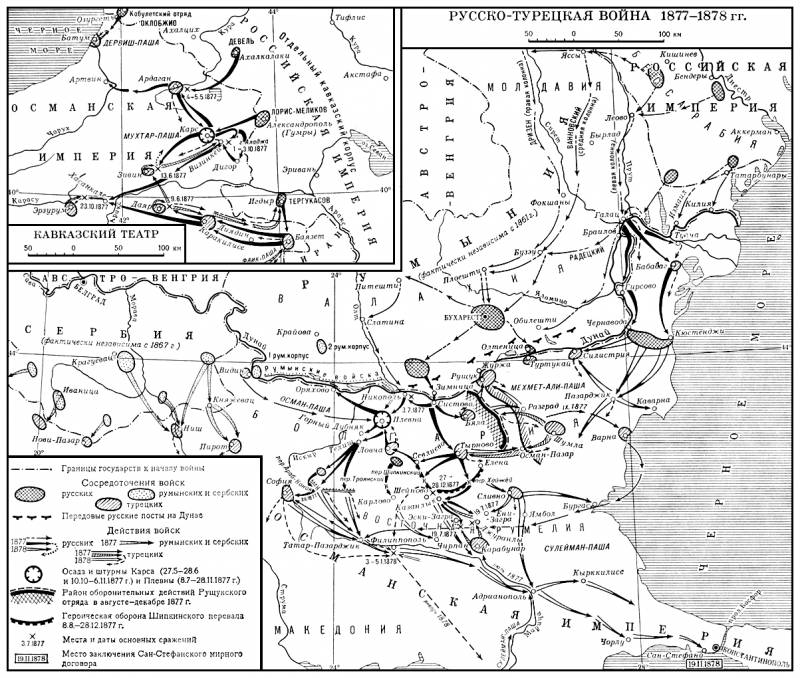Sturm Ardahan
 The concentration of Russian troops in the Caucasian theater began in August 1876. It was decided to send free troops of the Caucasian military district to the border with Turkey in order to keep the Anatolian corps of the Turkish army in Asia Minor, which the Ottoman government was going to transfer to the Balkans to suppress the uprising of the southern Slavs.
The concentration of Russian troops in the Caucasian theater began in August 1876. It was decided to send free troops of the Caucasian military district to the border with Turkey in order to keep the Anatolian corps of the Turkish army in Asia Minor, which the Ottoman government was going to transfer to the Balkans to suppress the uprising of the southern Slavs. In September, 1876, as relations with the Ottoman Empire deteriorated, the first sketches of a plan of war in the Caucasus were made. Initially, the Caucasian army was set to an active task: an attack deep into Anatolia in order to divert significant forces of the Turkish army and thereby contribute to the success of the Russian troops in the main Balkan theater, where the outcome of the war was decided. The general idea was formulated as follows: “The ultimate goal of our military actions by the Transcaucasus is not in Asian Turkey, but in the Balkan Peninsula. This goal will be achieved closer, the more Turkish forces we will attract and the more we occupy points and space in Asian Turkey ... The most important and profitable points for occupation are Kars and Erzerum, and everything possible must be done to master them. ” In addition to diverting the forces of the Turkish army from the Balkans, the Caucasian army had to break into the depths of the Turkish possessions and seize strategic points, which strengthened the security of the borders of the empire in the Caucasus, and raised the prestige of Russia among Caucasian peoples, Christians of Asia Minor - Armenians and Georgians. The liberation of the Christians of Asia Minor from Ottoman oppression was one of the tasks of the Russian army.
However, these tasks could only be accomplished by major offensive operations against the Turkish army. As a result, later, on the basis of erroneous intelligence data about the alleged double superiority of the enemy, the Russian command refused to use the benefits of a sudden major offensive operation to quickly capture Kars and Erzerum. Military action decided to proceed with caution. After the declaration of war, they planned to cross the border and take a profitable defensive line in order to reliably cover Russian territory from a possible enemy strike, and then act on the situation. Already before the beginning of the war, in March 1877, the military council, chaired by the commander-in-chief of the Caucasian army, brother of the emperor, Grand Duke Mikhail Nikolayevich, decided to strike the first blow against the Ardahan fortress and then block and take Kars.
The forces of the parties
Russia. On the eve of the war, the Russian Caucasian Army numbered over 95 thousand men and 276 guns. For the offensive against the Turkish Empire from the Transcaucasus, an active corps was formed from its troops as part of 52,5 thousand people with 160 guns. His commander was the cavalry general, M. T. Loris-Melikov. It was a brave and experienced military man who distinguished himself in the Caucasian War against the Highlanders and the Eastern (Crimean) War on the Caucasian Front. The Caucasian corps was divided into detachments in accordance with the main operational directions. On the right flank, at Akhalkalaki, the Akhaltsykh detachment, headed by Lieutenant-General F. D. Devel (13,4 thousand people with 36 guns), is located. In the center, near Alexandropol, are the main forces of the corps (more than 27 thousand people with 92 guns) under the personal command of Mikhail Loris-Melikov. On the left flank, at Igdir, stood the Erivan detachment of Lieutenant-General A. A. Tergukasov (11,6 thousand people with 32 guns). In addition, a separate Rion (Kobuleti) detachment under the command of Major General I. D. Oklobzhio (more than 24 thousand people with 96 guns) was located near the sea. The remaining troops of the Caucasian Army (about 19 thousand people with 20 guns) were concentrated in the area of Sukhum, in the North Caucasus, and made up a general reserve.
The Alexandropol detachment was to solve the problem of seizing Kars, and then act on the Erzurum direction. The Akhaltsykh detachment was to occupy Ardagan and ensure the operation of the main forces from the right flank, acting in the direction of Kars and Artvin. The Erivan detachment was to capture Bayazet, and then, in cooperation with the main forces, to attack the Alzerkert valley on Erzerum. Thus, the immediate task was to reach the Ardagan - Kars - Bayazet line. With the successful accomplishment of this task, it was further envisaged an offensive by all means on Erzerum and the seizure of this strategic fortress in Turkish Armenia. Further, the way was opened deep into Anatolia. The Oklobzhio seaside detachment was to conduct an offensive against the main city of Ajara, Batum.
Turkey. Before the outbreak of hostilities, Turkish troops in Anatolia were in the process of formation. In March 1877, Ahmed Mukhtar Pasha was appointed commander-in-chief in the Caucasus. He energetically embarked on the formation of a strong army capable of successfully conducting military operations in the Caucasus. At his request, the sultan sent 4 battalions and 20 squadrons to the 12 Corps. The Turkish command also divided the troops into detachments: Karsky under the command of the commander-in-chief, Ardagansky - Huseyn Serbi-pasha, Alashkertsky-Tatyr-oglu Mehmet-pasha, Van-Bayazetsky - Faik-pasha and Batumi - Dervisha pasha. The number of Anatolian army was 65-75 thousand people. With no quantitative and qualitative superiority over the Russians, and data on the number of Russian troops, the Turkish command decided to keep the defense. Mukhtar Pasha’s troops had to stop the enemy’s offensive in order to gain time to complete the strengthening of the support bases in Kars and Erzerum, to form and train the Anatolian army, then it was possible to launch a counterattack.
The outbreak of war
The troops of the Caucasian Army crossed the Turkish border 12 (24) on April 1877 with the declaration of war. A war veteran, in the future, the famous Russian general A. A. Brusilov, who served in the 15 Tver Dragoon Regiment as part of the Alexandropol squad, wrote in his memoirs: “April 11, although no one declared anything to us, a rumor spread that 12 let's cross the border. At 7 hours of the evening, the entire camp, on the orders of the corps commander, was surrounded by a thick chain, ordering no one to leave the city from the camp, and then at 11 hours of the evening all regimental adjutants were demanded to the corps headquarters, and there we were dictated by a manifesto declaring war the order of the corps commander, which indicated that the cavalry should cross the border at 12 hours of the night ... We spoke at 12.30 hours of the night and quickly approached the Turkish barracks, which stood on the right bank of Arpachai. The night was dark. The river was in full spill. We crossed over ford part and swimming. The Turks were fast asleep, and it took us a lot of effort to wake them up and demand that they surrender. After some negotiations, the Turks, seeing themselves surrounded, fulfilled our demand and surrendered without a single shot along with their brigadier commander. Our other column also successfully completed the assignment entrusted to it. We then captured more than forty Suvari (Turkish dragoons) and a hundred Turkish equestrian militia with a badge ”.
Thus, thanks to the swift actions of our cavalry (1-I Caucasian Cavalry Division) all Turkish posts were destroyed and captured. Only on one opponent had little resistance. One Cossack and four Turkish soldiers were killed in the battle. This provided favorable conditions for building bridges across the border river Arpachay in the area of Alexandropol. The offensive of the Russian army took the Ottomans by surprise.
From the experience of past wars, Mukhtar Pasha knew that the Russians would first of all try to occupy the Saganlug Range, which covered the path of Kars-Erzerum. In addition, he overestimated the strength of the Russian army. In order not to be surrounded, to preserve the freedom of maneuver and to maintain this important position, the Turkish commander-in-chief 15 (27) of April headed there from the Kars region with 5-thousand. detachment, leaving to protect Kars 15-thousand. garrison. Having strengthened on Saganlug, Mukhtar Pasha provided communication for Kars-Erzerum. From there he had the opportunity to attack the main forces of the Russian corps or to oppose the Erivan detachment. Also, Turkish troops could hinder the siege of Kars. Thus, the Turkish commander-in-chief hoped that the siege of Kars by the Russians would give him time to create a new large group of troops in the rear, in Erzerum, which could be opposed to the Caucasian Russian army.
The onset of the Russian troops took place in the difficult conditions of the spring thaw, artillery and wagons were stuck in the mud. Mountain roads became almost impassable. Therefore, the troops moved slowly. For two weeks, the main forces of Loris-Melikov occupied the eastern part of the Kara region. By April 27 (May 9) they came to Kars. In this situation, the Russian command could be limited to putting Ardagan and Kars in small barriers. The Turkish garrisons were not sufficiently combat capable, that they would organize a serious operation in the rear of the main Russian forces. And the main forces to organize a rapid movement on Erzerum, defeat the detachment of Mukhtar Pasha and take Erzerum, not ready for a strong defense. The Turks did not have serious forces in the Erzurum direction to stop the rapid movement of the Russian army. In this case, the advanced Turkish garrisons in Kars and Ardahan were doomed to a quick defeat. The Turks were deprived of a powerful support base, where they were going to create a strong army. The Russian army received a strategic point, with the help of which it was possible both to develop an offensive deep into Turkish territory, and to keep the defense, waiting for reinforcements from Russia. Also, the Russians seized the rich food resources of the Erzurum Valley.
Also, Russian troops could immediately go to the storming of Kars. The departure of the Mukhtar Pasha detachment weakened the garrison of the fortress, sowed fear and confusion in the Turkish troops and the population of the city. The Turks did not know the number of Russian troops, exaggerated their number. Nobody could help the Kara Fortress at that time. Thus, the moment for the assault was the most favorable. The immediate seizure of Kars also solved several important tasks: the Russians securely covered their border, receiving a strong stronghold, both for defense and for a further offensive, after reinforcements arrived; Russian army covered their communications. However, in this case, the Turks were given the opportunity to create a group in the Erzerum region.
The commander of the Caucasian Corps, General Loris-Melikov, did not use any of the opportunities that had been revealed. Having rejected the immediate attack on Erzerum and the immediate assault of Kars, he decided first of all to seize Ardahan, and then move against Mukhtar Pasha, defeat him and only after that come to grips with Kars. The immediate storming of Kars was considered impossible by Loris-Melikov, since, in his opinion, Kars could only be taken by a long siege. He wanted to take Ardagan in order to strengthen the main forces of the corps at the expense of the Akhaltsikhe detachment. As a result, this led to a delay in the campaign and the Turks gaining the time necessary for the formation of an efficient group of troops, and the organization of opposition to the Russian troops. The Ottomans received information that the Russians were not as many as they had previously believed. The initial panic in Kars subsided, the Turkish garrison came to its senses and prepared for a long siege.

Adjutant-General Prince DI Svyatopolk-Mirsky, Grand Duke Mikhail Nikolayevich, Adjutant-General MG G. Loris-Melikov (left to right). Kars. Xnumx
Taking Ardagan
However, at this time, the main events developed in the areas of operations of the Akhaltsy and Erivan detachments. The Russian army launched an offensive on the Ardagan direction. The Ardagan fortress, rather strong for that time, was located here, which guarded the road junction leading to Batum, Erzerum and Kars, and covered the routes from the Russian border through Olta to Erzerum. Given the importance of the strategic importance of this item, the Port did not spare funds for its strengthening. European specialists were also involved in this case. The key point in the Ardagan defense system was the Gulaverdynsk heights in 2-3 km east of the city and the separate steep Manglas mountain to the north. Gyulaverdynsky heights dominated the Akhalkalaki road, on which the Russian detachment advanced. On the heights the Turks erected a bastion-type fortification - Emir-ogly-Tabiya. Ahead were two forward strong points. On Mount Manglas there was the strongest fortification - Ramazan-Tabiya, from where the Turks could sweep all the approaches to the fortress from the north and northeast. The fortifications of Ardahan itself, located on both banks of the Kura, consisted of separate forts and lunettes. The citadel was poorly adapted to the modern war and in the event of the fall of other fortifications, it lost its importance. The Turkish garrison totaled more than 8 thousand people with 95 guns.
28 April (10 May) 1877, the Akhaltsykh detachment approached Ardahan and blocked the fortress. The Russian detachment numbered 8,5 thousand people with 28 guns. General Devel did not dare to open the assault on his own and requested reinforcements. The corps commander singled out a detachment under the command of General Gaiman from the main forces and went with him to Ardagan to head the general leadership by assault. After the arrival of reinforcements, the Akhaltsykh detachment numbered 15 thousand bayonets and sabers during the 20 siege and 56 field guns.
On the eve of a decisive assault they conducted a thorough reconnaissance of enemy positions. They decided to strike the main blow from the south, from where the Turks were least of all expecting an attack. But before the attack of the Ardagan fortress, it was necessary to take the Gyul'verdynsk heights. At night, prepared ten artillery batteries. Five batteries were intended for shelling of Emir oglu, five - city walls. At dawn 4 (16) of May 1877, the attack of Guliaverdy began. She was supported by strong 20 shells. Russian soldiers seized one by one enemy positions and approached the Emir oglu, from where the enemy fired at the attackers. As it turned out later, the Turkish gunners showed such courage due to the fact that they were chained to the guns. The soldiers who climbed the ridge just fell from exhaustion, they could not continue the assault. The reinforcements led by General Geiman came to the rescue, and the Emir-oglu took. Russian troops lost 24 people killed and 115 wounded during this attack. 9 Turkish guns and several hundred shells were captured. The swiftness of the offensive and well-thought-out artillery support ensured the success of the operation.
After the capture of the fortress Emir oglu and other positions of the Gyul'verdynskiy heights, the Russian troops were able to begin the second part of the operation - the assault on Ardahan itself. The city was stormed in two columns. The first column, under the command of General Devel, was appointed for a demonstrative attack on Ramadan, the second, led by Geiman, delivered the main attack from the south, with part of the forces from the east, from Guliaverdy. Loris-Melikov, did not dare to attack from the course, and decided to continue the operation only after a thorough two-day artillery preparation.
5 (17) May 40 guns mounted on the Gyulaverdynskiy heights, opened heavy fire on Turkish positions. Taking advantage of the confusion of the enemy, the Russian troops launched an offensive earlier than planned. The batteries, taking off from positions, went to the aid of the attacking infantry. The Turks lost morale and retreated in panic. By the morning of 6 (May 180), the Turks left without a fight the strongest fortifications - Ramazan-Tabia, on Mount Manglas. As a result, during the storming of the Ardagan fortress, Russian troops lost about 300 people killed and wounded. The loss of the Turkish garrison reached 3 thousand people. Among the trophies were 92 guns, up to 6 million cartridges, a lot of military equipment and supplies, in the amount of 4-5 million rubles. It was a complete victory. The remains of the Turkish garrison fled to Batum.
The Russian army captured an important fortress and communications hub. It was the first serious victory of the Russian Caucasian army. Russian troops intercepted the path that connected Batum with Kars and Erzerum. Now the troops of Mukhtar Pasha could not count on the support of the Primorsk detachment Dervish Pasha, who relied on Batum and the Ottoman Navy. The right flank of the Russian army was protected, and it could focus on the Kars-Erzurum direction. “The occupation of this fortified point,” noted the Minister of War D.I. Milyutin, “greatly facilitates our position in the theater of war and makes it possible to strengthen the main building aimed at Kars”.
The two-day assault on Ardagan showed the moral and military superiority of the Russian army over the enemy. Even relying on a strong and well-armed fortress, the Ottomans could not resist. The Russian infantry, and especially the artillery, performed well. The main part of the artillery attracted to the solution of combat missions in the main direction of attack, with the allocation of a small reserve. Describing her role in this matter, the commander-in-chief of the Caucasian army noted: “Ardahan fell mainly from the brilliant action of our glorious artillery; everyone is delighted with her well-aimed fire; he made a panic on the Turks. ”
Success in storming Ardagan again raised the question of what to do next. The withdrawal of Mukhtar Pasha from Kars and the relative weakness of the resistance of the Turkish garrison in Ardahan showed the weakness of the Turkish army and the need to take advantage of this. Loris-Melikov asked for instructions from the commander-in-chief. Loris-Melikov received an answer from him that the decision on the question of further actions was given to him and to the military council from the generals subordinate to him. The commander assembled a military council and put forward three options for discussion: 1) simultaneously carry out the siege of Kars and advance towards Erzerum; 2) engage in the siege of Kars and disregard the Mukhtar Pasha group; 3) throw a siege and do only the defeat of the troops of Mukhtar Pasha. The military council, under the influence of Geiman, inclined towards the second variant. Loris-Melikov himself was inclined to attack in the Erzurum direction, but he agreed with the opinion of the military council. They decided to proceed with the siege of Kars. On June 8, the fortress of Kare was blocked, siege batteries were built on June 12, and a regular siege began.
It was not the best solution. By the end of May, Loris-Melikov had 6 thousand people with 16 guns in Ardahan - after taking the fortress, part of the troops of the Akhaltsikhe detachment, renamed Ardagan, was taken to the main forces of the acting corps. 31 thousand people with 112 guns were located under Kars and 7,5 thousand people with 30 guns in the Erivan squadron. Mukhatr Pasha had 20 thousand people with 28 guns on the Olta line, Zivin, Alashkert. In the depths of the Caucasian theater, the Turks still had about 15 thousand people. Also, the Turks were much weaker in terms of quality, in terms of combat, their troops were only being formed, and were undergoing combat training. The Turks were much weaker in artillery and cavalry. Their forces were scattered over a large space. But the time factor was on the side of the Ottomans, the more the Russians lingered, the stronger became the Turkish army. Thus, the simultaneous offensive of the three main Russian detachments on Zivin, where the main forces of Mukhtar Pasha were deployed, led to a decisive success: the field Turkish army could be defeated in pieces. Loris-Melikov understood this, but did not dare to take responsibility for this great cause.

M.T. Loris-Melikov, 1878
Actions Erivan squad
On its left wing, the Russian army also won an important victory. The Terivkasov's Erivan detachment crossed the border of 17 (April 29) 1877 and moved to Bayazet. Cavalry avant-garde (3,5, thousand cavalry and 16 horse artillery guns) under the command of Major General Prince Amilokhvari was in the front as the detachment moved. The Turks had a garrison here in 1,5 of a thousand infantry and 500 horsemen, the Ottoman command hoped to detain the Russians. Mukhtar Pasha, in the instructions of the Vansko-Bayazet detachment, noted that “the Russians will invariably attack Bayazet, therefore, to save it, one must stop at nothing”. However, at the first appearance of the Russians, the Turkish garrison fled to the mountains of Ala-Dag in the direction of Van.
The Erivan squadron of 26 on April (8 of May) headed along the main Erzurum road to Jadin and occupied it on the same day. A small garrison was left in Bayazet, headed by Colonel Kovalevsky. In two weeks of the offensive, Russian troops occupied the entire Bayazet valley. Later Alashkert and Zeidekian were captured. Turkish troops retreated to Delhi Baba.
To be continued ...

Information